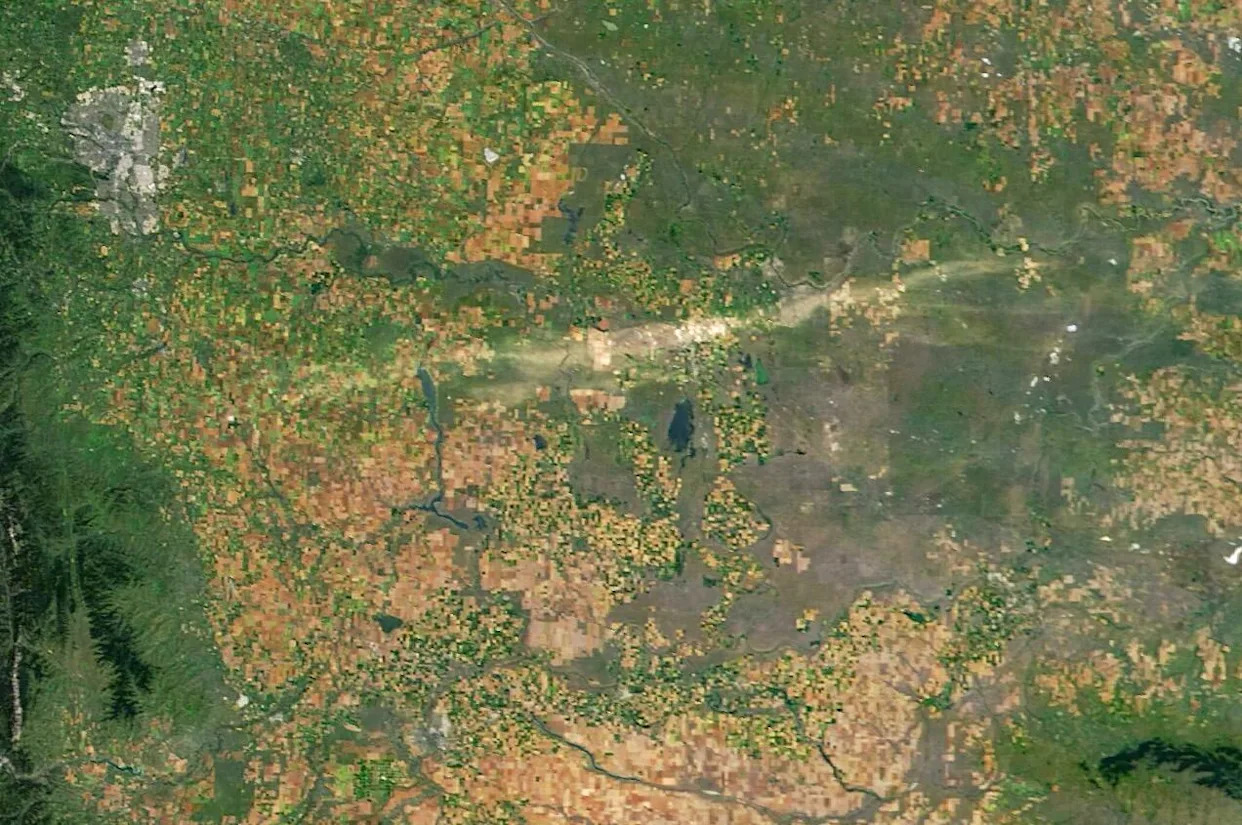Top Stories
Wind and Hail Carve 200-Km ‘Scar’ Across Southern Alberta

A powerful storm on August 20, 2025, unleashed winds reaching up to 150 kilometres per hour across southern Alberta, leaving a significant “scar” visible from space. The storm’s devastating impact spanned approximately 425,000 acres of crops and pastureland, resulting in extensive damage that researchers have called among the worst documented by the Northern Hail Project.
The storm system moved from south of Calgary to Saskatchewan, carving a path that measured about 15 kilometres wide and 200 kilometres long. Satellite images released by the U.S. space agency NASA illustrate the stark contrast between healthy vegetation and the affected area, where lush greens have been replaced by a barren expanse of destruction.
Extent of the Damage
The most severe damage occurred north of Brooks, where many farmers experienced catastrophic losses. Gerald Torkelson, a local farmer and landscape business owner, participated in cleanup efforts alongside nearly 100 volunteers from Mennonite congregations. He described the aftermath as unprecedented, stating, “My yard looks like the moon.”
Farmers are facing the difficult task of harvesting remaining crops while awaiting insurance assessments. The storm has left fields with little to salvage, prompting many to consider cutting damaged crops for livestock feed. Brad Osadczuk, a rancher near Jenner, noted that the wind flattened grass on grazing leases, which could significantly reduce grazing capacity for years. “Everything that was there is gone, so it’s a next-year deal,” he explained.
According to George Kueber, the provincial adjusting manager with the Agriculture Financial Services Corporation, the current situation is dire. “This is a large, large storm with lots of claims,” he said, emphasizing the devastating impact of the losses at this critical time in the growing season.
Recovery and Future Implications
Research conducted by scientists at Western University indicates that recovery from such storms can be a long process. Simon Eng, a meteorologist with the Northern Hail Project, explained that while crops can regenerate quickly in some cases, the timing of the storm is crucial. A previous storm in June 2024 produced regrowth within weeks, though it was less severe than the August event.
Barry Adams, a retired rangeland agrologist, highlighted the long-term consequences of localized damage on pasture health. He noted that ranchers must monitor their land closely, managing grazing to support regrowth. “Ranchers will need to monitor their pastures and recognize those areas needing special management to assist recovery,” he advised.
As the cleanup continues and assessments unfold, the impact of the storm will resonate in the region for years to come. With many farmers still recovering from previous drought conditions, the loss of crops has left them grappling with the harsh realities of nature’s unpredictability. The community’s resilience will be tested as they work toward recovery and rebuilding in the face of this unprecedented weather event.
-

 Science3 months ago
Science3 months agoToyoake City Proposes Daily Two-Hour Smartphone Use Limit
-

 Top Stories3 months ago
Top Stories3 months agoPedestrian Fatally Injured in Esquimalt Collision on August 14
-

 Health3 months ago
Health3 months agoB.C. Review Reveals Urgent Need for Rare-Disease Drug Reforms
-

 Technology3 months ago
Technology3 months agoDark Adventure Game “Bye Sweet Carole” Set for October Release
-

 World3 months ago
World3 months agoJimmy Lai’s Defense Challenges Charges Under National Security Law
-

 Lifestyle3 months ago
Lifestyle3 months agoVictoria’s Pop-Up Shop Shines Light on B.C.’s Wolf Cull
-

 Technology3 months ago
Technology3 months agoKonami Revives Iconic Metal Gear Solid Delta Ahead of Release
-

 Technology3 months ago
Technology3 months agoApple Expands Self-Service Repair Program to Canada
-

 Technology3 months ago
Technology3 months agoSnapmaker U1 Color 3D Printer Redefines Speed and Sustainability
-

 Technology3 months ago
Technology3 months agoAION Folding Knife: Redefining EDC Design with Premium Materials
-

 Business3 months ago
Business3 months agoGordon Murray Automotive Unveils S1 LM and Le Mans GTR at Monterey
-

 Technology3 months ago
Technology3 months agoSolve Today’s Wordle Challenge: Hints and Answer for August 19









